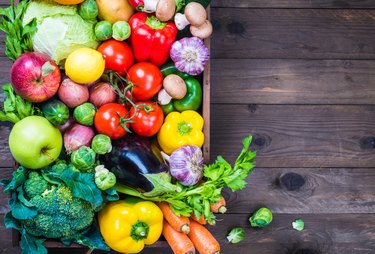
Want to drop a few pounds, but hate that gnawing feeling of hunger? Trying a trusted diet program like Weight Watchers is one way, especially if you lean on the zero-point foods. You read that right: There are tons of free foods on the plan that'll keep those hangry feelings at bay.
Fruits Are Free Foods
Video of the Day
In late 2015, Weight Watchers (which recently rebranded as WW) rolled out its new SmartPoints plan, which replaced the old Points Plus system. The result? All fruits have been made zero points in an effort to encourage dieters to eat plenty of fruits and vegetables. And basically, the sky's the limit. Every kind of fresh fruit, frozen fruit and fruit canned in unsweetened juice is free.
Video of the Day
However, if a fruit has been dried, sweetened or canned in syrup, then you'll have to count the points (sorry!). If you need some help finding fun fruits to try, check out the USDA's ChooseMyPlate fruit page.
But steer clear of the juice and smoothie fad. You'll not only have to count the points you consume in these drinks, but you could also end up consuming more. As it turns out, drinking food is not nearly as satisfying as chewing it — and science backs this up. A 2015 study in Physiology and Behavior found that those who chewed their food ate less and reported less hunger.
Most Vegetables Are Zero Points, Too
If you're a veggie lover and you're considering a weight-loss plan, keep reading. Non-starchy vegetables — such as leafy greens, carrots, tomatoes, green beans, asparagus, onions, broccoli and radishes — are all zero-point foods on the SmartPoints plan, and research proves they're the key to weight loss. According to the Centers for Disease Control and Prevention, a diet focused on fruits and vegetables (plus whole grains, low-fat dairy and lean meats) can help you cut calories.
Vegetables give you a big nutritional bang for your buck, which means you get a lot of nutrients from a small number of calories. They typically have a high water and fiber content as well, which can help you feel fuller for longer. Try adding extra veggies to your morning omelet or your favorite soup to make it more filling (for zero points!).
But know that starchy vegetables — such as potatoes, winter squash, peas and corn — are higher in calories and are not included on the zero points list. However, these higher-calorie veggies are rich in certain nutrients, so don't cut them out completely.
Some Condiments and Snacks Are Free
If your food tastes delicious, you're more likely to stick to your eating plan, right? Well, good news: You can enjoy plenty of flavorings on WW — referred to as flavor boosters — and you can add them for zero points. Fresh and dried herbs, salsa, vinegar, hot sauce, mustard, reduced-sodium soy sauce, capers, citrus juice or zest, pickled jalapeños and unsweetened pickles are all "free" flavor boosters. Some tasty suggestions: Splash roasted veggies with balsamic vinegar, add salsa to a baked potato instead of butter and sour cream and replace mayo with vinegar for a zesty tuna salad.
A few snacks, such as sugar-free gelatin and sugar-free frozen pops, are also considered zero-point foods. And sugar-free beverages are points-free, too. Just remember that these treats might help satisfy your sweet tooth, but they don't carry any nutritional value.
Portion Size Matters on Weight Watchers
While free foods don't contribute to your points total, remember that many of them still contain calories. For instance, a medium banana contains 105 calories, and a cup of grapes has 104 calories. If you overindulge in fruit because it's a free food, those calories could add up and you could actually sabotage your weight loss. The USDA recommends that adults consume between 1 1/2 and 2 cups of fruit daily. As for veggies, aim to eat 2 1/2 to 3 cups per day.
You'll get minimal calories from the sugar-free treats and beverages on the zero points list, but overconsuming them might hinder your weight-loss efforts as well. In fact, research from the Harvard T. H. Chan School of Public Health notes that artificially sweetened beverages actually contribute to weight gain rather than weight loss, possibly because they affect the reward center in the brain differently from natural sweeteners, which results in cravings.
For the best results on the WW program, enjoy your free points foods to help stay satisfied — but practice moderation, and focus on eating only when you are truly hungry.
- Weight Watchers: "The SmartPoints Plan"
- Centers for Disease Control and Prevention: "Low Energy-Dense Foods and Weight Management: Cutting Calories While Controlling Hunger"
- Weight Watchers: "Fruit and Veggies vs. Smoothies - SmartPoints and Eating Guide"
- USDA ChooseMyPlate.gov: "All About the Fruit Group"
- Physiology and Behavior: "Effects of Chewing on Appetite, Food Intake and Gut Hormones: A Systematic Review and Meta-Analysis"
- Weight Watchers: "Top 10 Ways To Give Condiments a Flavor-Boost"
- Harvard T. H. Chan School of Public Health: "Low-Calorie Sweeteners"
- Harvard School of Public Health: Artificial Sweeteners